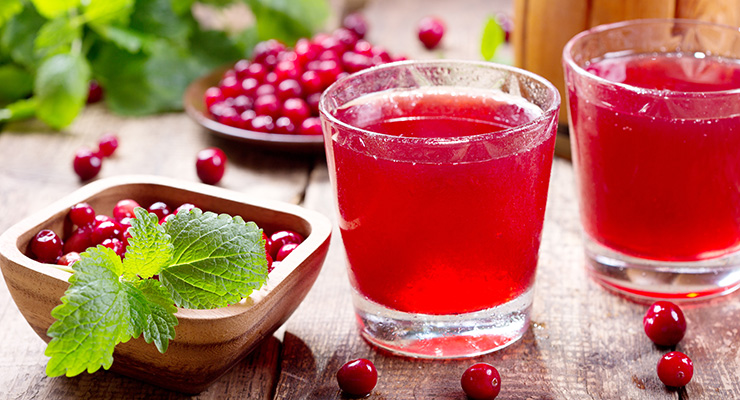Features
Cochrane Review Supports Cranberry for Preventing UTI Recurrence
Evidence mounts for the health benefits of PACs, and future innovations in quality and testing will improve efficacy while revealing other health benefits.

By: Mike Montemarano

Cranberry juice and cranberry supplements both can significantly reduce repeat urinary tract infections (UTIs) in women, children, and individuals at risk due to medical procedures involving the bladder.
According to researchers writing in the Cochrane Database of Systematic Reviews, the meta-analysis is the most comprehensive to date on the matter, and is an update of previous reviews published in the journal.
This news comes nearly three years after the U.S. Food and Drug Administration announced a qualified health claim that certain types of cranberry products can reduce the risk of recurrent UTIs in healthy women.
“Now that we have included 50 studies in the review, we now have more conclusive evidence to support the efficacy of cranberry preparations in reducing the risk of symptomatic urinary tract infections in women with recurrent UTIs, children, and in people with a susceptibility to UTI due to an intervention such as radiation therapy,” said Elisabeth Hodson, corresponding author of the study and honorary consultant pediatric nephrologist at the Children’s Hospital at Westmead in Sydney, Australia.
Each year, more than 400 million cases of UTI are reported globally. Cranberry products can serve as a cost-effective means of prevention, the authors concluded.
Amy Howell, PhD, a researcher who has investigated the relationship between cranberry consumption and UTI incidence for 30 years at Rutgers University, noted that standardizing products for concentrations of proanthocyanins (PACs) has been key in developing cranberry products that work as intended.
“The meta-analysis stresses the importance of utilizing cranberry products standardized for PAC content,” Howell said. “We have determined that PACs in juice-based products are most effective for UTI prevention and should be consumed daily.”
“PACs found in cranberries help prevent bacteria from adhering to the bladder wall. This adhesion of bacteria is what causes UTIs,” Howell continued. “Because bacteria are unable to ‘stick’ to the bladder, the UTI does not progress, eliminating the ultimate need to use antibiotics because the infection is prevented.”
Hodson said that while the mechanism of action behind PACs is poorly understood, they are thought to work specifically against the adhesion of E. coli among other harmful bacteria strains. There isn’t enough information on PACs to suggest at this time that this mechanism can lead to other health benefits, Hodson said.
Review Details
Across the 50 studies assessed, which involved 8,857 people, there were no significant differences in whether cranberries were taken in the form of juice, tablets, or capsules.Of the 50 studies, 45 studies compared cranberry products to either a placebo or no specific treatment. Twenty-six of the 45 studies could be analyzed for outcomes related to symptomatic, culture-verified UTIs.
Outcomes involving a total pool of 6,211 participants yielded moderately-certain evidence that cranberry products reduced UTI risk in women, children, and people who had interventions leaving them susceptible to UTIs.

More to Learn About PACs
It was unclear based on the evidence whether there were any differences in outcomes in cranberry supplementation versus either antibiotics or probiotics in comparison studies, the authors said. Additionally, it was unclear based on the evidence whether high or low doses of PACs, or whether taking a juice vs. a tablet/capsule, made a difference in efficacy.However, the results suggest that adherence is easier for consumers when taking cranberry tablets, as opposed to drinking large quantities of juice. “There was only one small study comparing 100 women with recurrent UTIs which directly compared tablets with juice and found no difference in efficacy,” Hodson said.
As more studies quantify PACs content, it’s safe to anticipate that recommendations on dosage will become more specific, Hodson told Nutraceuticals World.
“There are no formal standards for PAC content in Australia and I am not aware of the standards in other countries,” said Hodson. She referenced a 2021 study, published in BMC Urology, which assessed two preparations of known PAC content, which yielded 20% reductions in UTI incidence in women with recurrent UTI.
“Their [Babar, et al.] introduction discusses the poor data on standardization of cranberry products currently available. I think that earlier studies, particularly using cranberry juice, had no standardization of dosing and simply used available cranberry products, and these studies may or may not have used sufficient PAC. In addition, adherence by patients to the products, particularly cranberry juice, would have compromised efficacy,” Hodson said.
A New Era in Standardization
Several new game-changing analytical tools are becoming mainstream in the cranberry market today, answering calls for better product standardization, noted Jean Leclerc, sales and business development manager at Fruit d’Or, a cranberry ingredient supplier known for its signature ingredient CranNaturelle.Fruit d’Or has been working with third-party testing company Complete Phytochemcial Solutions to bring Maldi-TOF testing into the mainstream as the most fit-for-purpose identity and authenticity testing method to quantify total PACs content, and to identify common adulterants which can’t be detected by other methodologies.
A few years ago, a study evaluating several different methodologies against one another revealed that different principles for the measurement of PACs was yielding inconsistent results, and many products were failing anti-adhesion tests partly as a result of faulty identification tests. For instance, the Bate Smith methodology found that a cranberry product had five times the amount of PACs compared to when tested using a method called DMAC.
Peanut skin and grape seed extract, both rich in PACs, can only be identified as adulterants through Maldi-TOF. While able to slip by detection of inferior methods, Maldi-TOF testing shows clear differences by providing an entire mass spectral fingerprint and not just a quantification of total PACs, according to Christian Krueger, CEO of Complete Phytochemical Solutions. “Lots of companies have adopted it as a preferred analytic tool and it’s becoming a specified requirement imposed by many manufacturers.”
In 2019, Complete Phytochemical Solutions introduced the first testing method (the butanol-hydrochloric acid method) which could quantify the insoluble PACs found within a cranberry, which are located in the fibers. Prior to this, research conducted on cranberries focused on a smaller family of PACs found within the juice of a cranberry. This new testing methodology opens the window into investigating the health-promoting properties of the family of PACs which have largely been ignored.
“We brought issues of adulteration to the attention of an AOAC International working group and over a number of years have come away with two main fit-for-purpose testing methods: the DMAC method [a colorimetric method to determine total soluble PACs content], and the Maldi-TOF method, which breaks things down into individual proanthocyanins,” Krueger said.
Fruit d’Or has sought to raise the bar on market-wide cranberry testing by promoting the latest testing methods as a contributor to the Botanical Adulterants Prevention Program, said Stephen Lukawski, CEO of RSSI (Research Science Specialty Ingredients) and lead sales consultant and partner for Fruit d’Or. “Adulteration is alive and well and while you can’t stop all bad actors you can raise the bar, but it’s important to remember they’ll always be out there.”
Lukawski noted that Fruit d’Or brings to the table “a vertically-integrated operation with complete control of quality and traceability from start to finish.”
Advanced analytical techniques can go so far as to determine whether one batch of cranberry powder was produced using the same raw material source as another, according to Leclerc. “Vertical integration, combined with these new testing methodologies, means a great deal for standardization. Raw material coming from one stable source is resulting in a standard profile of PACs and chemical fingerprint from batch to batch … If raw material on a batch-to-batch basis isn’t the same, it’s a bit of an issue for competitors claiming that their product will always perform in the same way.”
“We’re a third-party analytical lab,” said Krueger, “and it’s really important to get verified by an entity at that arm’s distance to support the identity, quality, standardization, and efficacy of a product. These ingredients ultimately move out of a vertically-integrated supply chain when they reach a customer, but we’re very familiar with the line items in Fruit d’Or’s and other partners’ offerings and know how to run the analytics for those specific products. This is the only way to achieve continuity when a product is removed from vertical integration.”

Optimizing Dosages
To date, the industry-standard minimum dosage of 36 mg of PACs is supported by research specific to soluble PACs only, with relevance only to outcomes related to UTIs.“Most companies were previously producing juice-only powders, so soluble PACs standards were easy to develop, Leclerc said. “When we produce whole fruit cranberry powder, 70% of those PACs are insoluble and segregated to the berry’s skin, and when you work with just juice, you’re missing out on all of those compounds unique to the cranberry. There’s still work to be done on determining the best dosages for insoluble PACs, or for other health outcomes.”
Standardization can mean different things to different people, noted Krueger. “What’s critical is that materials used in products are manufactured in a consistent way in order to remain efficacious. PACs are an umbrella covering multiple compounds, and there’s up to 30 degrees of polymerization. Among other things, polymer lengths have an impact on bioavailability, and insoluble PACs have a distinct role within the lining of cell walls, so the relative concentrations of each PAC is attributable to outcomes. This is in addition to the fact that testing for relative concentrations of PACs helps to support the identity of an ingredient.”
Future Discoveries
The ability to test for both insoluble and soluble PACs today will help make discoveries in emerging areas beyond the role of cranberry in UTIs, experts noted.The anti-adhesion activity present in the broad spectrum of PACs is thought to have similar potential in other mucosa, where it may prevent the adhesion of other harmful bacteria besides E. coli in the mouth, skin, and digestive tract. One breakthrough study conducted in China, for instance, found that cranberry juice consumption was linked to a significant reduction in H. pylori infection.
“There may be potential oral hygiene benefits, like reducing the formation of biofilms on the teeth, gums, and tongue, which is where bacteria colonize,” Lukawski noted. “So cranberry doesn’t have anti-microbial activity, but might be able to remove that biofilm that harmful bacteria cling to. There’s also work being done in the area of cardiovascular health. But much more work is still needed in each of these areas. The FDA’s recognition of insoluble PACs by requiring whole fruit powder and excluding juice powder in supplements to carry health claims, and the new test methods to quantify insoluble PACs, are all opening up the window today to investigate other health benefits for the first time.”
Researchers are just starting to understand how the interactions between bacteria and mucosa may have implications in other diseases besides UTI, such as stomach ulcers, noted Leclerc. “Over the next few years, it’s likely that there might be more discoveries related to cranberry’s role in the general ecology of the GI tract, and more answers on the differences between soluble and insoluble PACs for human health.”
Insoluble PACs, like any other phytochemical, are complex structures, and interact with the body in complex ways. “We truly don’t understand them very well, especially in the area of the gut microbiota,” Leclerc added.
On the topic of future testing innovations, the next step will be developing bioassays in order to determine the efficacy of a given cranberry product—namely, how the activity of an extract interacts with a bodily structure, said Krueger. “This will truly serve the need to demonstrate that products will be consistently productive batch to batch.”


